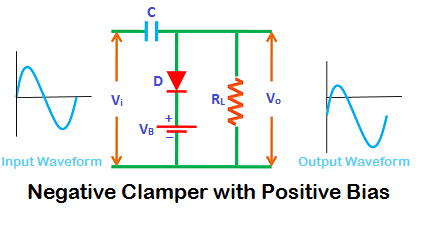Diode in Clamping Circuit
The positive or negative peak of an input signal is shifted or altered to a desired level using a clamper circuit. This circuit is also known as a DC restorer or a Level Shifter. Depending on the diode configuration, these clamping circuits might be positive or negative.
Negative peaks are elevated upwards in a positive clamping circuit until they reach the zero level. Positive peaks are clamped in a negative clamping circuit, and the positive peaks are pushed downwards until they reach the zero level.
There are 3 types of Clamper Circuits
1. Positive Clamper

2. Negative Clamper

3. Biased Clamper

|
 |
 |
 |
Protection Circuits
In a circuit, a diode is employed to protect against reverse polarity. A battery with the wrong polarity can damage the circuit's components. In such circumstances, a diode that permits current to flow in just one way is employed to stop the current flow.
It is also used in circuits powered by Solar panels to avoid discharge of battery due to flow of current from battery to the solar panel as shown in a image below.

High voltage surges are suppressed using a special type of diode known as a TVS (transient voltage suppression) diode. These diodes do not conduct under normal circumstances, but they prevent component damage by grounding large voltage spikes.
 |
 |
Logic Gates using Diode
In forward bias, the diode acts as a switch ON, and in reverse bias, it acts as a switch OFF in RDL (Resistor Diode Logic) logic. It can be used to create simple logic gates with diodes and resistors. DTL (Diode Transistor Logic) are also used to create simple logic circuits.
| RDL |
DTL
|
 |
 |

|
 |

Light Detector
A photodiode is a light-sensing diode that converts light energy into electrical energy. It is designed with an exposed junction with an opening for light. When the photon particle hits its junction, it releases an electron-hole pair that creates a potential across its terminals. Current passing through the photodiode can only flow in one direction based on the P and N doped materials. If reverse biased, current will not flow through a photodiode without incident light creating photocurrent.

|
 |

AM Envelope Detector
The simplest and cheapest circuit for demodulating an AM signal is a diode with a capacitor. Because the diode only allows the positive half cycle of the signal, the audio message signal is stored in the envelope of the AM modulated signal, which is detected by the diode. By deleting all high frequency components of the signal, an envelope detector can be used to demodulate a previously modulated signal.


